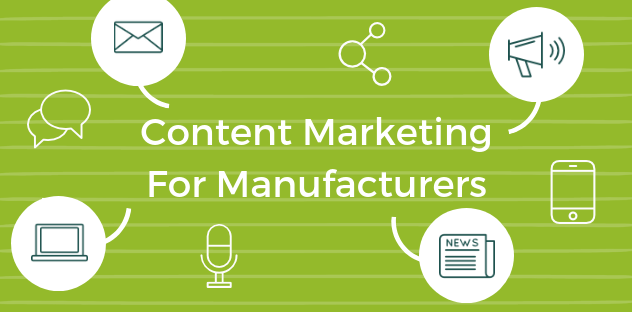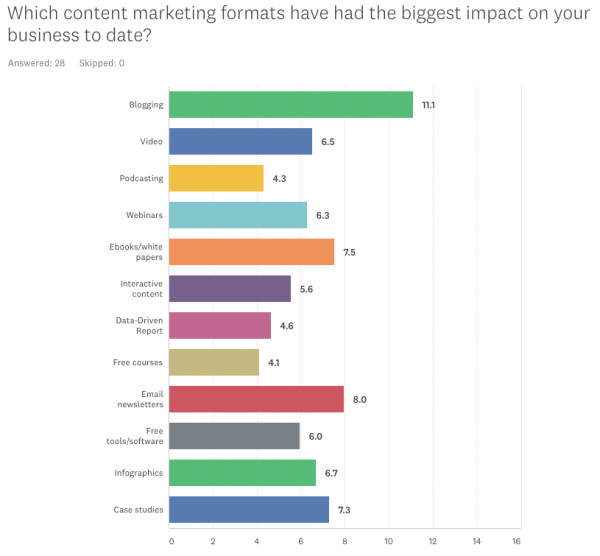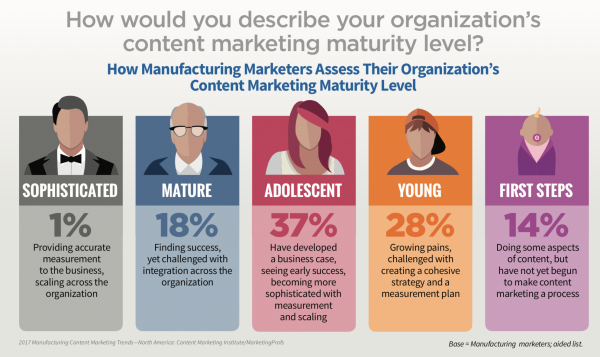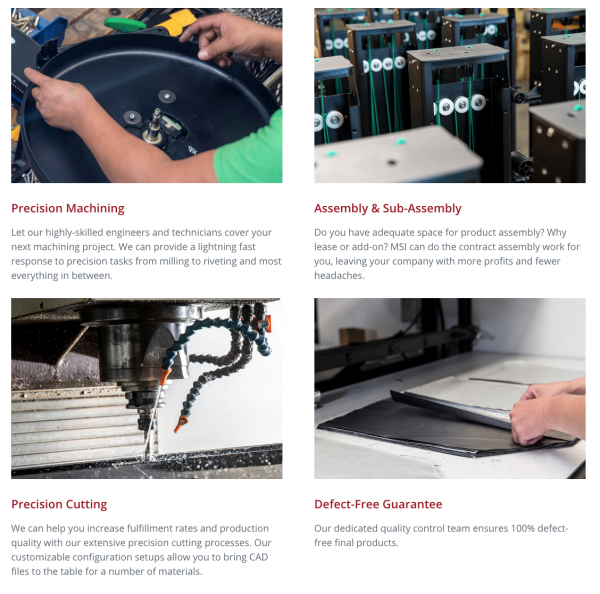The Importance of Content Marketing for Manufacturers

Whether a marketing team is tasked with building leads, supporting distributors and suppliers, or delighting customers, their number one priority should be content marketing. There are many marketing strategies that provide a quick short-term gain, but when the initiative is all said and done the return on investment stops.
That approach isn’t necessarily wrong. However, teams that get results know they need to pair paid results with organic messaging as well. That’s where content marketing makes an appearance.
What is content marketing?
Content marketing has been around a long time, it’s the influencer of many traditional marketing actions. As a business strategy, it spans the expertise of your sales, marketing, and customer service teams.
Content marketing is about creating and distributing marketing material which provides value to a specific target audience through a variety of outlets. It’s not meant to be pushy or in your face but gives audiences access to information that is beneficial to them.
The idea is simple enough, yet everyone has a different sense of what they consider to be beneficial and of the most value. This means marketing teams should be creating content for viewers who are just starting their purchasing journey all the way through customer evangelists.
The end result of content marketing is to drive positive customer action. This can mean a purchase, improved user experience, retaining services, cross-selling, or helping customers find what they need.
Types of content marketing
Content marketing is everywhere. It influences more marketing channels than you’d initially think. Essentially, it’s the bridge between traditional advertising and newer online strategies. Marketing would not be possible without remarkable content.
Most marketing efforts revolve around content creation;
Social media requires profiles with copy and imagery that helps explain an organization. When creating posts people share blog links, write stories, or include infographics.
Email campaigns require writing copy that should be differentiated according to each market segment.
Videos as a content marketing medium have informed dramatic increases in engagement and visibility. This is mostly due to easy access to video cameras and multiple platforms offering video features, like Facebook Live, Youtube, and Vimeo. In their newest video study, HubSpot reported 81% of businesses surveyed were using videos to amplify their marketing efforts and 99% of those utilizing videos felt their efforts were paying off.
SEO can’t be successful without great website content. Search engines find it difficult to place a website in relevant search results if they don’t have well-crafted copy.
Public relations targets article placement and press coverage, both of which involve written content.
Inbound marketing is the nurturing of leads by providing valuable insights at every stage of the sales funnel. A direct influencer to increased website traffic.
Digital advertising combines short taglines and eye-catching ad design. This is true for traditional advertising as well. Advertisers have always struggled with the question of how to create relatable content that doesn’t disrupt the viewer's activity and captures their attention.
For every company, the type of content that is most effective for their audience will be different. Databox surveyed their customers and found that the split is all over the board.

With blogging leading the way, there was a wide split between which other content formats people used. That’s because a podcast might generate a high return on investment for a software company and a data-driven report might be more effective to many of the technical buyers seen in manufacturing organizations. No two scenarios are exactly alike.
Why is content marketing important for manufacturers?
Quality content drives more website traffic and ultimately more sales conversions. However, that’s only part of the story.
The majority of manufacturing organizations are behind the ball when it comes to content marketing. A 2017 survey from the Content Marketing Institute (CMI) shows manufacturers are struggling to adopt this process. Talk about a blessing in disguise.

The CMI report goes on to show only a combined 19% of manufacturers interviewed felt they had a successful grasp on content marketing. This leaves 81% struggling to find a foothold in one of the most important communication channels.
It’s always positive to be an industry leader. Those who do take advantage will find less competition vying for leads through content-rich channels like search rankings and public relations. Less noise clears the airways and gets content in front of the desired audience.
Content Marketing Real-World Examples

Bluehouse Group client, NRG Systems designs and manufactures smart technologies for the renewable energy market. Their products are used by electric utilities, turbine OEMs, project developers, research institutes, and government agencies all around the world.
Before redesigning their website they had an issue with product installation contractors not being able to easily find calibration specifications, technical documents, or instruction manuals. Knowing this, Bluehouse Group developed a product and technical support category. These gave the marketing and support teams a place to collaborate and create documents, how-to videos, and FAQs that address each product's specs.
With these changes to their website content, NRG saw a drastic decrease in calls to their support department. Freeing up their team to focus on generating more content and creating an overall happier clientele base. These are tangible results to an organization’s bottom-line expenditures due to content marketing.
That’s just one part of the customer lifecycle.
Another of Bluehouse Group’s clients, Manufacturing Solutions Inc. (MSI), a successful contract manufacturing company had a low text-per page volume when we started working together. This resulted in search engines struggling to pinpoint the optimal search terms to rank MSI on.
Bluehouse Group was able to create website copy in relation to MSI’s specific contract manufacturing capabilities, like precision cutting, and assembly services. After these pages were introduced to the MSI website they quickly rose in rankings for local search terms for each of these services. MSI’s website saw an increase in local search traffic and prospects seeking the contract offerings they could supply.

Content marketing is a long-term strategy
Content compliments or influences almost every marketing strategy. What most people miss about creating content is that it holds a permanent foothold wherever it’s published. As more articles are created, infographics designed, and social media posts published, you build a compounding return on investment.
Advertisements stay up for as long as you pay for the ad space. Once the budget runs out, they’re gone. When content is created it builds on itself, the blog posts that were published last year will still be there as more are published this year. Website traffic grows, subscribers sign-up for more news, new leads are converted, and customers find the frequently asked questions they need to stay happy.
It takes time to build a successful content churning machine, but when it’s actively running the value can last indefinitely.
Getting started with content marketing
Set up content goals
The first step to start content marketing is to understand the desired outcome. What are the specific KPIs that should be measured to determine if efforts and initiatives are paying off? Setting goals are critical to finding that success.
Content that is created just for the sake of creating content - more than likely - won’t produce great results. Consider what are the current marketing categories that need a boost, like:
- Brand awareness
- Lead capture
- Lead nurturing
- Customer retention
- Evangelist conversion
All of these outcomes require a different type of content. Customer retention might require the creation of a knowledge center that helps address common questions or pain points; while lead capture depends on landing pages and lead magnets (product catalogs, white papers, checklists, etc.)
Create a content strategy
Don’t go searching for a content strategy template. This isn’t a one-size-fits-all kind of project, but there are a couple of critical pieces that should be used to set a foundation.
Ideal customer profiles (ICP):
An ICP assists in recognizing what buyers are trying to accomplish, how they accomplish it, their pain points, and business goals. It’s a requirement. They may feel like a squishy first-step that can be skipped, however, that would be a disservice to the effectiveness of future content development. The factors identified within an ICP hold a direct influence over the forms of content that are created and the mediums through which they are distributed.
Marketing channel plan:
This plan should be put in place to determine where content is distributed. Depending on audience type, some channels will prove to be more effective than others. Does the target audience read industry publications or are they more receptive to blog posts? Realistically, the content in these two mediums could be identical, although one won’t hold the same value as the other if the audience doesn’t hold the channel in high regard.
Content calendar:
Know when, where, and how often content is being published. Content calendars help marketing teams stick to a timeline that fits within their capacity and keeps them honest when new content is due.
Follow through:
Whatever form of content that has been decided on and whichever mediums for distribution are utilized, stick to the schedule, and just do it. That’s easier said than done. When a new process is started it can be painful to keep pace. Once people have been held accountable to schedules and deadlines it becomes another everyday task. Whether the content is short videos, industry magazine columns, blogs, or social media posts, they will eventually become a routine.
Content marketing is the past, present, and future
There’s no doubt that content marketing has sticking power. People respond to artfully crafted words, imagery, and videography. The only thing that will change are the channels to reach prospects and the mediums used to digest new content.
Today videos and podcasts are surging in popularity, but tomorrow that may change. Voice search, AI chatbots, and virtual reality are all new mediums in which marketers are exploring. Nonetheless, they all still rely on content marketing.
Marketing teams that want to find success, no matter their designated KPIs, will find themselves leaning on the prioritization of content marketing in all its forms. There are lots of ways to approach this initiative, if you want help determining how to get started or expand on these efforts, we can help.